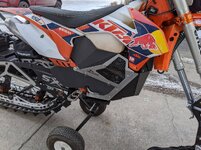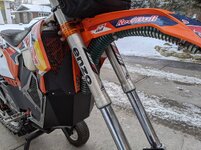...small trimming on backside of Selkirk plastic to clear yeti
From conversation with Marc and from looking at all the builds on the Selkirk website, the Selkirk rear side plastic is intended to overlap the snowbike kit. All the way up to the belt drive on that side and overlap the snowbike kit side panel on the non-drive side. No doubt one can trim it though so they sit further in if one prefers that look or it may be required since there is some variance in the provided panels. I plan on leaving mine (see the first two pictures in this thread). Will monitor it for rubbing on the yeti finish, though, and cut shorter if that occurs.
I did notice, in the above pics, that I didn't tuck the left side upper panel tab under the YZ side numberplate which I will do when I put the side panels back on. Those small tabs, on various panels and depending on bike, are intended to tuck under something. I'd just slapped them on for a quick picture then took them back off. Going to try to get out for the very first break in run today (just some trail out and back to stretch chain and track) and planned on leaving the side panels in the trailer. Really nice feature they go off and on so quick and no messing with bungee cords or rubber ties like my previous engine blanket.
Last edited:






